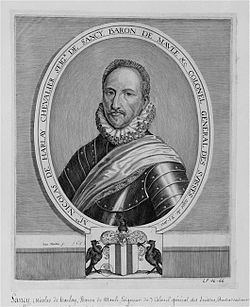Name Nicolas Harlay, | Children Achille Harlay de Sancy | |
 | ||
Nicolas de Harlay, seigneur de Sancy (1546–1629) was a French soldier and diplomat.
Contents
Life
Although de Harlay belonged to the Protestant branch of the family of Harlay, he adopted the Catholic religion in 1572 during the massacres of the Huguenots. In 1589 he obtained in Geneva and Berne sums sufficient to raise an army of mercenaries for Henry III, partly by the sale of jewels, among them the Sancy diamond which in 1835 found its way to the Russian imperial treasure, and partly by leading the Swiss to suppose that the troops were intended for serious war against Savoy.
Henry IV made him superintendent of his finances in 1594, but in 1599 he was replaced by Maximilien de Béthune, duc de Sully. Meanwhile he had been a second time converted to Catholicism, but his influence at court waned, and he retired from public life in 1605. He survived until the 13th of October 1629, leaving a Discours sur l'occurrence des affaires.
His son, Achille Harlay de Sancy (1581–1646), was bishop of Saint-Malo.
Sancy diamond
The Sancy diamond's known history began circa 1570 in Constantinople when purchased by de Sancy. Something of a gem connoisseur, de Sancy used his knowledge to prosperous advantage.
Henry III of France suffered from premature baldness and tried to conceal this fact by wearing a cap. As diamonds were becoming increasingly fashionable at the time, Henry arranged to borrow de Sancy's diamond to decorate his cap. Henry IV also borrowed the stone, for the more practical purpose of using it as security for financing an army. Legend has it that a messenger carrying the jewel never reached his destination, but de Sancy (by then Superintendent of Finance) was convinced that the man was loyal and had a search conducted until the site of the messenger's robbery and murder was found. When the body was disinterred, the jewel was found in the faithful man's stomach.
De Sancy later sold the diamond to James I (successor of Queen Elizabeth) about 1605 when it is thought the Sancy acquired its name. It was described in the Tower of London's 1605 Inventory of Jewels as "...one fayre dyamonde, cut in fawcetts, bought of Sauncy."
